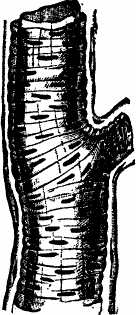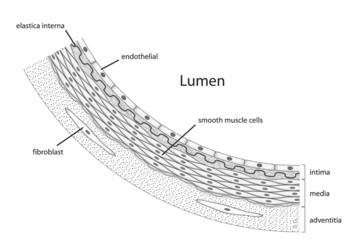Artery: Difference between revisions
Revert to edit by Dina, 16:07, 29 October 2006 |
|||
| Line 34: | Line 34: | ||
====Functions of capillaries==== |
====Functions of capillaries==== |
||
Capillaries have no [[smooth muscle]] surrounding them and have a diameter less than that of a [[red blood cells]]; a red blood cell is typically 7 micrometers outside diameter, capillaries typically 5 micrometers inside diameter. The red blood cells must distort in order to pass through the capillaries. |
Capillaries have no [[smooth muscle]] surrounding them and have a diameter less than that of a [[red blood cells]]; a red blood cell is typically 7 micrometers outside diameter, capillaries typically 5 micrometers inside diameter. The red blood cells must distort in order to pass through the capillaries. I hate you all pre[are to die hahahaha |
||
This small diameter of the capillaries provide a relatively large surface area for the exchange of gases and nutrients. |
This small diameter of the capillaries provide a relatively large surface area for the exchange of gases and nutrients. |
||
Revision as of 21:29, 22 November 2006

Arteries are muscular blood vessels that carry blood away from the heart. They are contrasted with veins, which carry blood toward the heart.
The circulatory system is extremely important in sustaining life. Its proper functioning is responsible for the delivery of oxygen and nutrients to all cells, as well as the removal of carbon dioxide and waste products, maintenance of optimum pH, and the mobility of the elements, proteins and cells of the immune system. In developed countries, the two leading causes of death, myocardial infarction and stroke each may directly result from an arterial system that has been slowly and progressively compromised by years of deterioration. (See atherosclerosis).
Description
The arterial system is the higher-pressure portion of the circulatory system. Arterial pressure varies between the peak pressure during heart contraction, called the systolic pressure, and the minimum, or diastolic pressure between contractions, when the heart rests between cycles. This pressure variation within the artery produces the pulse which is observable in any artery, and reflects heart activity.
Anatomy

The outermost layer is known as the tunica adventitia or the adventitia, and is composed of connective tissue. Inside this layer is the tunica media, or media, which is made up of smooth muscle cells and elastic tissue. The innermost layer, which is in direct contact with the flow of blood is the tunica intima, commonly called the intima. This layer is made up of mainly endothelial cells. The hollow internal cavity in which the blood flows is called the lumen.
Types of arteries:
There are several types of arteries in the body:
Pulmonary arteries
The pulmonary arteries carry deoxygenated blood that has just returned from the body to the lungs, where carbon dioxide is exchanged for oxygen.
Systemic arteries
Systemic arteries deliver blood to the arterioles, and then to the capillaries, where nutrients and gases are exchanged.
The Aorta
The aorta is the root systemic artery. It receives blood directly from the left ventricle of the heart via the aortic valve. As the aorta branches, and these arteries branch in turn, they become successively smaller in diameter, down to the arteriole. The arterioles supply capillaries which in turn empty into venules.
Arterioles
Arterioles, the smallest of the true arteries, help regulate blood pressure and deliver blood to capillaries.
Arterioles and blood pressure
Arterioles have the greatest collective influence on both local blood flow and on overall blood pressure. They are the primary "adjustable nozzles" in the blood system, across which the greatest pressure drop occurs. The combination of heart output (cardiac output) and total peripheral resistance, which refers to the collective resistance of all of the body's arterioles, are the principal determinants of arterial blood pressure at any given moment.
Capillaries
Though not considered true arteries, the capillaries are where all of the important action happens in the circulatory system:
Functions of capillaries
Capillaries have no smooth muscle surrounding them and have a diameter less than that of a red blood cells; a red blood cell is typically 7 micrometers outside diameter, capillaries typically 5 micrometers inside diameter. The red blood cells must distort in order to pass through the capillaries. I hate you all pre[are to die hahahaha
This small diameter of the capillaries provide a relatively large surface area for the exchange of gases and nutrients.
What capillaries do:
- In the lungs, carbon dioxide is exchanged for oxygen
- In the tissues, oxygen and carbon dioxide and nutrients and wastes are exchanged
- In the kidneys, wastes are released to be eliminated from the body
- In the intestine, nutrients are picked up, and wastes released
Blood pressure
Systemic arterial pressures, are generated by the forceful contractions of the heart's left ventricle. (See blood pressure)
Healthy resting arterial pressures, are relatively low, mean systemic pressures typically being under 100 mmHg, about 1.8 lbf/in², above surrounding atmospheric pressure (about 760 mmHg or 14.7 lbf/in² at sea level).
To withstand and adapt to the pressures within, arteries are surrounded by varying thicknesses of smooth muscle which have extensive elastic and inelastic connective tissues.
The pulse pressure, i.e. Systolic vs. Diastolic difference, is determined primarily by the amount of blood ejected by each heart beat, stroke volume, versus the volume and elasticity of the major arteries.
Over time, elevated arterial blood sugar (see Diabetes Mellitus), lipoprotein cholesterol, and pressure, smoking, and other factors are all involved in damaging both the endothelium and walls of the arteries, resulting in atherosclerosis or Diabetes Mellitus.
History
Among the ancient Greeks, the arteries were considered to be "air holders" that were responsible for the transport of air to the tissues and were connected to the trachea. This theory presumably arose from the fact that the arteries are empty after death: the last beat of the heart pushes the blood through the capillaries and into the veins.
In medieval times, it was recognized that arteries carried a fluid, called "spiritual blood" or "vital spirits", considered to be different from the contents of the veins. This theory went back to Galen.
William Harvey described and popularized the modern concept of the circulatory system and the roles of arteries and veins in the 17th century.
